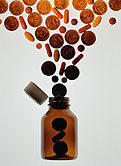
WEDNESDAY, Nov. 16 (HealthDay News) — Overall outpatient use of antibiotics in the United States fell about 12 percent between 1999 and 2007, but alarmingly high use in the Southeast could speed the development of antibiotic-resistant bacteria, researchers warn.
The findings were released by Extending the Cure, a project of the Center for Disease Dynamics, Economics & Policy in Washington, D.C.
The five states with the highest antibiotic use are West Virginia, Kentucky, Tennessee, Louisiana and Alabama. Residents of West Virginia and Kentucky take about twice as many antibiotics per capita as those living in Oregon and Alaska.
Penicillins are the most popular antibiotics and account for nearly one out of every three prescriptions filled in the United States. But the market share of penicillins has fallen 28 percent as doctors increasingly turn to more powerful antibiotics, according to a news release from Extending the Cure.
Between 1999 and 2007, prescribing rates for a powerful class of antibiotics called fluoroquinolones rose 49 percent. But with increasing antibiotic resistance, these drugs are now seven times less likely to work against E. coli than they were in 1999.
The release of the findings coincides with this week’s U.S. Centers for Disease Control and Prevention’s annual campaign to reduce antibiotic overuse.
More information
Here’s where you can find information on the CDC’s Get Smart: Know When Antibiotics Work campaign.

